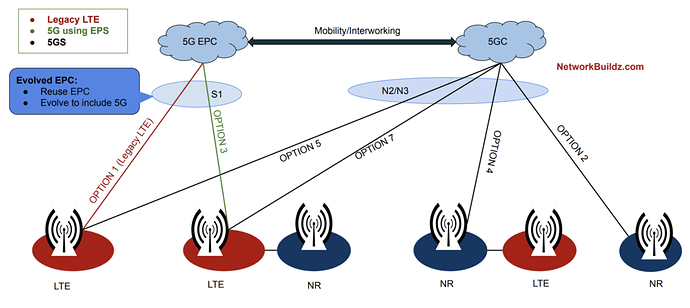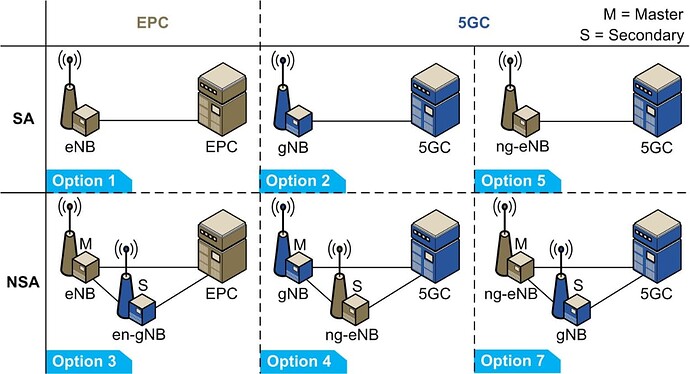𝐇𝐨𝐰 𝐭𝐨 𝐃𝐞𝐩𝐥𝐨𝐲 5𝐆 𝐒𝐀 𝐚𝐧𝐝 𝐍𝐒𝐀?
“5G offers endless possibilities, but its deployment varies. Operators choose options based on spectrum, geography, equipment, and business factors. 3GPP guidelines ease the transition from 4G to 5G. Typically, 5G NR deploys first, coexisting with 4G RAN. Then, the 5G Core arrives. Expect 4G+5G handsets connecting seamlessly to both 4G eNB and 5G gNB.”
𝐖𝐡𝐢𝐜𝐡 𝐚𝐫𝐞 𝐭𝐡𝐞 𝐦𝐚𝐢𝐧 5𝐆 𝐝𝐞𝐩𝐥𝐨𝐲𝐦𝐞𝐧𝐭 𝐨𝐩𝐭𝐢𝐨𝐧𝐬?
𝐎𝐩𝐭𝐢𝐨𝐧 1 (𝐞𝐍𝐁 + 𝐄𝐏𝐂):
It represents the foundational LTE (4G) connectivity deployment. In this configuration, the eNB connects to the 4G Core Network, forming the backbone of 4G cellular communication. This setup enables high-speed data transmission and typical 4G services.
𝐎𝐩𝐭𝐢𝐨𝐧 2 (𝐠𝐍𝐁 + 5𝐆𝐂):
It entails a standalone 5G deployment. Here, the gNB (5G New Radio Base Station) connects directly to the 5G Core Network. This setup harnesses the full potential of 5G technology, enabling ultra-low latency, massive device connectivity, and advanced services like network slicing.
𝐎𝐩𝐭𝐢𝐨𝐧 3 (𝐄𝐏𝐂 + 4𝐆 𝐞𝐍𝐁 𝐦𝐚𝐬𝐭𝐞𝐫 + 5𝐆 𝐞𝐧-𝐠𝐍𝐁 𝐬𝐞𝐜𝐨𝐧𝐝𝐚𝐫𝐲):
One of the most popular options within the NSA (Non-Standalone) framework. It combines 4G (eNB master) and 5G (en-gNB secondary) components, both connected to the existing 4G EPC. This hybrid approach allows for the coexistence of 4G and 5G, enhancing data speeds while leveraging the 4G core network’s infrastructure.
𝐎𝐩𝐭𝐢𝐨𝐧 4 (5𝐆𝐂 + 5𝐆 𝐠𝐍𝐁 𝐦𝐚𝐬𝐭𝐞𝐫 + 4𝐆 𝐧𝐠-𝐞𝐍𝐁 𝐬𝐞𝐜𝐨𝐧𝐝𝐚𝐫𝐲):
It represents a deployment where the 5G Core Network (5GC) is integrated with a primary 5G gNB and a secondary 4G ng-eNB. In this setup, 5G is the primary network, while 4G serves as a complementary technology.
𝐎𝐩𝐭𝐢𝐨𝐧 5 (𝐧𝐠-𝐍𝐁 + 5𝐆𝐂):
This is a deployment scenario where the Next-Generation eNodeB (ng-eNB) connects directly to the 5G Core Network (5GC). This configuration is characteristic of a standalone 5G (5G SA) deployment, offering the full suite of 5G capabilities independently.
𝐎𝐩𝐭𝐢𝐨𝐧 7 (5𝐆𝐂 + 4𝐠 𝐧𝐠-𝐞𝐍𝐁 𝐦𝐚𝐬𝐭𝐞𝐫 + 5𝐠 𝐠𝐍𝐁 𝐬𝐞𝐜𝐨𝐧𝐝𝐚𝐫𝐲):
It features a deployment where the 5G Core Network (5GC) is at the core, with a primary 4G ng-eNB master and a secondary 5G gNB. In this setup, 4G serves as the primary access network, while 5G gNB acts as a supplementary technology.
𝐎𝐩𝐭𝐢𝐨𝐧 6 (4𝐆 𝐂𝐨𝐫𝐞 + 5𝐆 𝐠𝐍𝐁 ):
This configuration may not be as attractive because it doesn’t fully leverage the capabilities of a 5G core network (5GC)
𝐎𝐩𝐭𝐢𝐨𝐧 8 (5𝐆𝐂 + 4𝐆 𝐞𝐍𝐁 + 4𝐆 𝐧𝐠-𝐞𝐍𝐁 𝐬𝐞𝐜𝐨𝐧𝐝𝐚𝐫𝐲):
The 5G Core Network (5GC) is deployed alongside a primary 4G eNB and a secondary 4G ng-eNB. This configuration may be used when transitioning from 4G to 5G, but it doesn’t maximize the potential of 5G technology.
Credits: 


